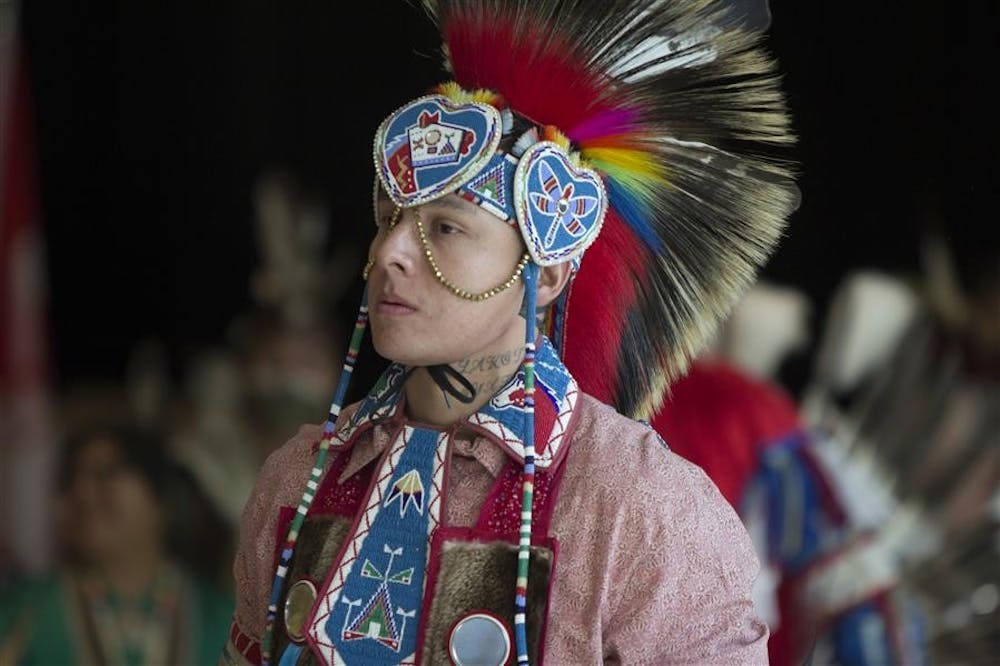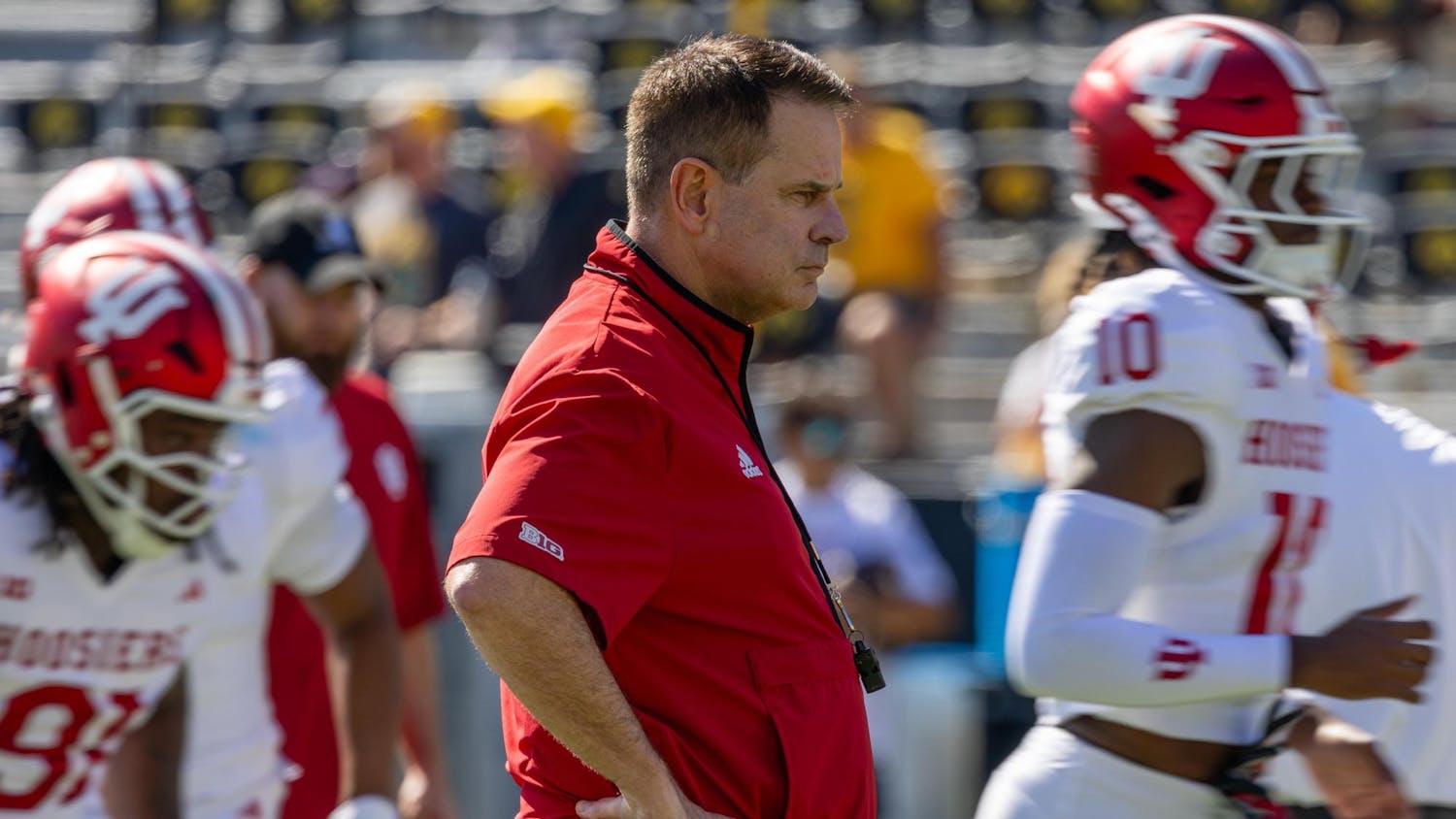The room was almost silent aside from the jingle of eager bell-laden feet as the dancers prepared to take their first steps in an inter-tribal dance.
A single voice rose from the silence to sing the first lyrics in a seldom spoken but cherished ancestral language. He was soon joined by the voices of many and the heavy beat of a drum.
At the Third Annual Traditional Powwow, which took place Saturday and Sunday at the Willkie auditorium, Native Americans celebrated their heritage in song and dance.
Tribal members in brightly colored garb danced in a toe-heel step around the heartbeat of their circle, the drum, to celebrate Native American Heritage Month.
One dancer of Cherokee descent, Galvlo’i Awoha’li, wore a horse tail headdress called a roach, a bandoleer, a ribbon shirt, a hand-beaded belt and moccasin shoes.
“We dress powwow,” Awoha’li said. “Prior to somewhere around 1950s, we dressed tribally, but nowadays we put on things that are just popular in powwows.”
Awoha’li also carried a drop fan made with the feathers of the red-tailed hawk, which is traditionally used in gourd dancing.
Awoha’li, 71, started dancing about 20 years ago, but most people start dancing when they’re children, he said.
Awoha’li said there are many different kinds of dances, including grass dance, straight dance, fancy dance, shawl dance and a few others.
“Everyone is welcomed to dance,” Awoha’li said. “The powwow changed from a tribal gathering to an inter-tribal gathering. There are different kinds of dancers. I’m a straight dancer because I’m old and I don’t do fancy stuff.”
Two dances performed during the grand entries, the primary dance segments, were the chicken dance by head man dancer Isaiah Stewart and the jingle dress dance, performed by head lady dancer Charlie Cuny.
The powwow was sponsored by the Native American Graduate Student Association, the First Nations Educational and Cultural Center, the Office of the Vice President for Diversity, Equality, and Multicultural Affairs, the Office of First Year Experience and the IU Student Association.
The event opened with the gourd dance, a group of men dance while the women gather behind the dancers and gently move to the beat.
The dance honors veterans and community elders, according to a press release. After the gourd dance, a community lunch was served followed by performances by drum groups, singers and the ceremonial grand entries representing tribes from across the United States and Canada.
Powwows allow multi-tribal populations with different political and social agendas to share their experiences of being Native Americans in the U.S., said Brian Gilley, director of the First Nations Educational and Cultural Center and an associate professor of anthropology in a press release.
Outside of the performance room, venders lined the hallways displaying an assortment of Native American crafts, clothing and tokens similar to those worn by performers.
Awoha’li said his token is the wolf because he is part of the wolf clan, the Cherokee nation in the south.
Because of his connection to wolves, he said he considers his dogs as family.
“I have two beagles, and they are not pets,” Awoha’li said. “They are my daughters. Their totem animal is the human and my totem animal is the dog.”
There are seven clans of the Cherokee nation, one of which is the eagle. Though the eagle is a symbol for a specific Cherokee clan, bald eagle feathers are sacred to all tribes of the Native American community.
Awoha’li told several stories depicting Native American beliefs.
The creation of many elements, such as fire and air, can be linked to Native American stories about specific animals.
A water spider introduced the concept of fire to society, Awoha’li said.
“We have lots of stories, and most of them emphasize humility and unpridefulness,” Awoha’li said.
Images of these animals, such as the water spider, could be seen on the clothing items worn by tribe members during the powwow.
For Awoha’li, a powwow is a spiritual and rhythmic experience.
“The drum is the center of everything,” Awoha’li said. “The drum is our heartbeat. I have sat more than once and found my pulse and found that it is beating exactly with the drums. It’s remarkable.”
Awoha’li said he did not know the origin or definition of the term “powwow,” but to him it has a meaning that is beyond just words.
“On Sundays I go to church and worship God with a book of common prayer,” Awoha’li said. “In powwows we dance. We dance to worship the creator. It’s our Sunday service. It’s more than that, but that’s how dancing began, as a means to worship God.”
A single voice rose from the silence to sing the first lyrics in a seldom spoken but cherished ancestral language. He was soon joined by the voices of many and the heavy beat of a drum.
At the Third Annual Traditional Powwow, which took place Saturday and Sunday at the Willkie auditorium, Native Americans celebrated their heritage in song and dance.
Tribal members in brightly colored garb danced in a toe-heel step around the heartbeat of their circle, the drum, to celebrate Native American Heritage Month.
One dancer of Cherokee descent, Galvlo’i Awoha’li, wore a horse tail headdress called a roach, a bandoleer, a ribbon shirt, a hand-beaded belt and moccasin shoes.
“We dress powwow,” Awoha’li said. “Prior to somewhere around 1950s, we dressed tribally, but nowadays we put on things that are just popular in powwows.”
Awoha’li also carried a drop fan made with the feathers of the red-tailed hawk, which is traditionally used in gourd dancing.
Awoha’li, 71, started dancing about 20 years ago, but most people start dancing when they’re children, he said.
Awoha’li said there are many different kinds of dances, including grass dance, straight dance, fancy dance, shawl dance and a few others.
“Everyone is welcomed to dance,” Awoha’li said. “The powwow changed from a tribal gathering to an inter-tribal gathering. There are different kinds of dancers. I’m a straight dancer because I’m old and I don’t do fancy stuff.”
Two dances performed during the grand entries, the primary dance segments, were the chicken dance by head man dancer Isaiah Stewart and the jingle dress dance, performed by head lady dancer Charlie Cuny.
The powwow was sponsored by the Native American Graduate Student Association, the First Nations Educational and Cultural Center, the Office of the Vice President for Diversity, Equality, and Multicultural Affairs, the Office of First Year Experience and the IU Student Association.
The event opened with the gourd dance, a group of men dance while the women gather behind the dancers and gently move to the beat.
The dance honors veterans and community elders, according to a press release. After the gourd dance, a community lunch was served followed by performances by drum groups, singers and the ceremonial grand entries representing tribes from across the United States and Canada.
Powwows allow multi-tribal populations with different political and social agendas to share their experiences of being Native Americans in the U.S., said Brian Gilley, director of the First Nations Educational and Cultural Center and an associate professor of anthropology in a press release.
Outside of the performance room, venders lined the hallways displaying an assortment of Native American crafts, clothing and tokens similar to those worn by performers.
Awoha’li said his token is the wolf because he is part of the wolf clan, the Cherokee nation in the south.
Because of his connection to wolves, he said he considers his dogs as family.
“I have two beagles, and they are not pets,” Awoha’li said. “They are my daughters. Their totem animal is the human and my totem animal is the dog.”
There are seven clans of the Cherokee nation, one of which is the eagle. Though the eagle is a symbol for a specific Cherokee clan, bald eagle feathers are sacred to all tribes of the Native American community.
Awoha’li told several stories depicting Native American beliefs.
The creation of many elements, such as fire and air, can be linked to Native American stories about specific animals.
A water spider introduced the concept of fire to society, Awoha’li said.
“We have lots of stories, and most of them emphasize humility and unpridefulness,” Awoha’li said.
Images of these animals, such as the water spider, could be seen on the clothing items worn by tribe members during the powwow.
For Awoha’li, a powwow is a spiritual and rhythmic experience.
“The drum is the center of everything,” Awoha’li said. “The drum is our heartbeat. I have sat more than once and found my pulse and found that it is beating exactly with the drums. It’s remarkable.”
Awoha’li said he did not know the origin or definition of the term “powwow,” but to him it has a meaning that is beyond just words.
“On Sundays I go to church and worship God with a book of common prayer,” Awoha’li said. “In powwows we dance. We dance to worship the creator. It’s our Sunday service. It’s more than that, but that’s how dancing began, as a means to worship God.”






